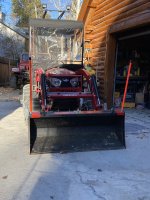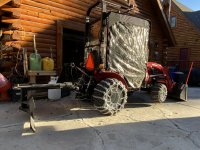Do rear wheel weight let you operate in 2 wheel drive more? Just bought a Kubota
M7060 and this is my first experience with this type of braking system. I usually drive in 2wd with the brake pedals split for manoueverability and was driving down the raod (dirt) and when I hit the brakes the rear wheels locked and I hardly even slowed down. Very scary! Now using 4wd all the time but have to switch to 2wd for sharp turns.
Did you have a load in the bucket? That will change weight distribution enough so that the brakes cause the rear tires to skid. Skidding the rears with a load in the bucket is VERY DANGEROUS GOING DOWNHILL.
Tractors only have brakes on the rear tires. Driving in 4wd couples the front tires to the rear mechanically...so the effect is as though you have brakes on the front as well. You always do that going down hills. But they are still undersized 2 wheel mechanical brakes.
Most of us simply do not drive a tractor very fast and never fast when it is loaded. The brakes are inadequate at best of US tractors. So go slow, especially down hill. Don't tow much and always be prepared to drop the bucket or implement to the ground for an anchor.
It's differerent in Europe, their tractors are decades ahead in tractor technology.
Oh, all US tractors are 4wd assist. They are not made to be run in 4WD all the time. The front tires need to slip to avoid torsional wind-up on the transmission and driveshafts. You can tell when this is happening because it will become very difficult to shift out of 4wd.
You will have to rock it back and forth to get the 4wd lever to move. That is your warning sign that the shafts have torsional stress on them. And it is the only one you get.
You can use 4wd all the time of course if you don't mind risking the repairs. It's only money....
Most of us use 4wd only when we must unless the surface is slippery like a dusty road or icy drive. And even there don't drive in 4wd unless you have to. Especially with the loader bucket full.
enjoy!
rScotty


